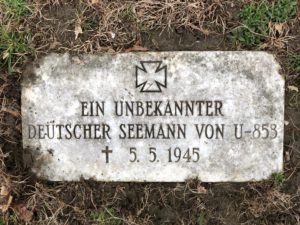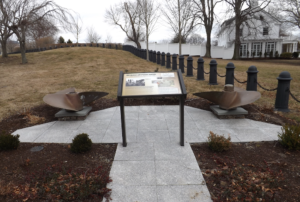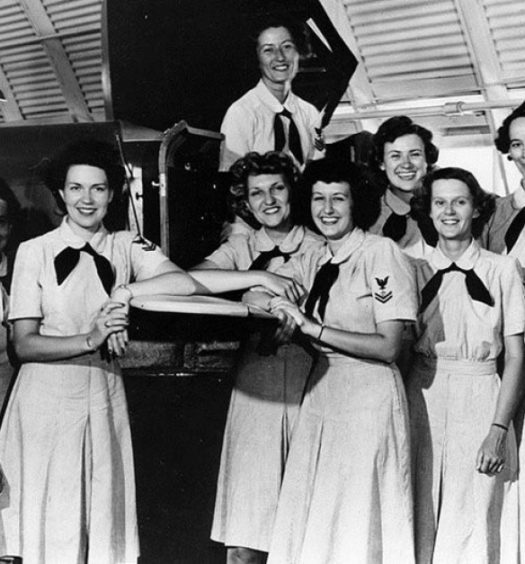[This is the last in a series of four articles honoring the 75th anniversary of the Battle of Point Judith. This article is mostly from part of a chapter written by the author in the book World War II Rhode Island (History Press, 2017).]
As described in the last three installments of this series, on May 5, 1945, a German U-boat, U-853, torpedoed and sunk the coal collier Black Point less than three miles southeast of Point Judith. Twelve of the vessels forty-six crewmen were killed by the blast or drowned. The next day, again within sight of Point Judith, and also Block Island, the German submarine was itself sunk by U.S. navy ships, resulting in the loss of life of all fifty-five submariners aboard U-853.
The sinking of U-853 was far from the end of its saga. Perhaps the most interesting part of its story occurred after its destruction.

The crew of U-853 enjoying themselves before the next patrol. Lieutenant Frömsdorf, the commander on the submarine’s last patrol, is in the center wearing a tie.
The first effort to reach the sunken submarine was made late in the day of May 6, 1945. A diver from the submarine rescue vessel USS Penguin, which had arrived from New London, found the wreck of U-853 in 130 feet of water. The diver landed on the conning tower and reported that the submarine was lying on its side with its hull split open and with bodies strewn about inside. He saw only two direct hits. Later that day, Navy divers attempted to enter the wreck to recover the submarine commander’s safe and the papers within, perhaps even to find the latest top-secret enigma coding machine.
The Naval War College Museum at Newport has in its possession a letter, apparently written in about 1960, from Penguin’s former skipper to a chaplain at the Newport Navy base that elaborates on the diving efforts made by he and his crew from May 5-6, 1945. The first page with the main text of the letter survives, but the second page showing the signature and date of the letter is missing. The letter’s author was very probably Lieutenant Commander George Waugh Albin, Jr., the commander of the Penguin from May 29, 1944 to May 28, 1945. (Brian Wallin, a co-author of World War II Rhode Island, provided me with a copy of the letter).
Albin wrote of operations that occurred on May 6, “My diving officer, Chief Gunner Bockelman, and I made a joint dive in the vicinity of the conning tower and observed a hatch to be open. Mr. Bockelman, being quite small, wormed his way into the conning tower while I tended him and shortly thereafter pushed a body up to me which I moored a line to and had hauled up to the surface.” The letter-writer added, “As I recall, the name of this seaman was Hoffman, a young lad of about 20, very well equipped in a black leather coat, his escape lung was on and ripped down the middle of the front as if it had suffered a sudden concussion after being inflated, possibly by a depth charge.” A list of U-853’s crew includes Herbert Hoffmann, aged twenty-three at the time he perished off Point Judith.
The skipper of the Penguin wrote further, “Groping in the crowded conning tower, as I recall, Gunner Bockelman thought there were six other bodies and as we were about to take them out, orders came over the diving telephone relayed from Sub Base, New London, to secure all operations.”
The disappointed divers later learned that recovery operations were called off because the war against Germany was about to end (the German articles of surrender were signed early in the morning of May 7) and because it was dangerous to dive around so much unexploded ordinance. Gunner Edwin J. R. Bockelman was later awarded the Navy and Marine Corps Medal for his bravery in volunteering to enter the conning tower hatch.
It is not known what the Navy ultimately did with Hoffman’s body. German submariners who died at sea were typically buried at sea by U.S. Navy forces that found them, but resort to that method was not necessary when Penguin was so close to land.
Captain Bill Palmer, after the publication of his book in 2012 about the sinking of U-853 and his efforts to dive into it, obtained from a researcher copies of the ship logs for a rescue tug, USS ATA-125, which often assisted Penguin. Palmer shared the copies with me (currently, the location of the original logs, the National Archives at Silver Spring, Maryland, are closed). The ship’s log for ATA-125 indicate that in the early afternoon of May 7, the tug boat departed the New London Submarine Base at Groton, Connecticut, to meet Penguin, which was returning from Narragansett Bay. On board the tug boat was Lieutenant Commander (j.g.) I. Dye. Around 3 p.m., in the Thames River near the lighthouse, Dye went in a whaleboat from the tugboat to Penguin, retrieved Hoffman’s body, and returned with it to ATA-125. The tugboat’s log then reports that the vessel steamed back to the New London Submarine Base at Groton. After arriving at Groton, the tugboat’s log provides that at 9:25 p.m., “Body of crewman of German U-boat removed from ship in custody of Lt. Comdr. I. Dye.” (I determined that he was Ira Dye, a former submarine commander in the Pacific theater during the war who retired from the Navy in 1967 and became a noted early U.S. navy historian).
Palmer, in his book, reports of his interview with Clary Edwards, one of the Navy divers on board Penguin on May 6, 1945. Edwards was next to dive when the mission was called off. Edwards’s recollection of that day’s dive was consistent with that of Albin’s in the letter quoted above. Edwards added, “Hoffman’s body was brought to the surface and pulled into a small tender [and] then taken aboard Penguin. Hoffman was dressed in a gray leather jacket and gray leather pants and wore a small black bow tie around his neck. The bow tie was made of aluminum.” Edwards said that the body was later taken to New London, Connecticut, where an autopsy was performed. Edwards recalled hearing that it was determined that Hoffman had perished from a concussion, as there was no water in his lungs.
Based on Edwards’s recollection that an autopsy was performed on Hoffman’s body at New London, Lieutenant Commander Dye must have brought the submariner’s body to medical personnel at the Navy’s submarine base at Groton on May 7. The medical personnel who performed the autopsy were likely associated with the Naval Submarine Medical Research Laboratory that is still part of the New London Submarine Base at Groton.
The trail of Hoffman’s body then ends. Palmer searched records of funeral homes active in New London in May 1945 and gravestone markers in cemeteries in the New London area. It is probably the case that Navy personnel in Groton had Hoffman buried locally in an unmarked grave.
The sinking of U-853 was immediately covered by local and national newspapers. On May 16, the Associated Press ran a photograph of items from the submarine recovered on the surface, including Lieutenant Frömsdorf’s hat.
Some residents along the southern Rhode Island coastline came across the cargo of Black Point in the days after its May 5, 1945, sinking. Janet Carpenter Vanderlaan of Perryville in South Kingstown still remembers the excitement in the Perryville, Matunuck and Green Hill areas caused by the coal ship’s sinking. She further recalls the cold, raw day in May a few days later when, as a thirteen year-old, her aunt took her to Green Hill Beach to join a host of others picking up coal that had washed ashore and placing it in their burlap bags.

Ensign Warren A. Allen (left) and Lieutenant S.F. Regard (right), on board the Coast Guard frigate Moberly, probably on May 6, 1945, examine articles from U-853 that floated to the surface after the submarine was blasted with depth charges and hedgehogs. One of the items that floated to the surface, not in this photograph, was the commander’s hat worn by Lieutenant Frömsdorf (National Archives)
In 1946 and 1947, the submarine’s two large bronze propellers, and one or two of the main deck guns, were removed and brought to the surface by unauthorized divers. The Coast Guard seized the propellers and displayed them for many years at Castle Hill. Later they were sent to the Island Cemetery Annex. They are now nicely exhibited on the grounds of the Naval War College at Newport.
One of the submarine’s 37mm anti-aircraft deck guns, according to Varoujan Karentz, a co-author of Untold Stories from World War II Rhode Island, was found in a field in New Jersey in 2004. He believes it has been refurbished and is now intended to be displayed in Delaware at the Fort Miles Museum and Historical Area. He does not know what happened to the second anti-aircraft deck gun. He found one note that it may have been blown off by depth charges. (Varoujan will have an article for our website about his efforts to locate the propellers, deck guns, and other U-853 artifacts).
Recreational divers first visited the site in 1953. In the summer of 1960, Burton Mason of Trumbull, Connecticut, removed the remains of a crewman, which were buried with full military honors in Newport’s Island Cemetery Annex on October 24, 1960. In attendance at that unusual ceremony included the German consul general in Boston, a commander of the German Navy, and navy officers from the Newport Naval Base.
The white headstone marking the grave of the unidentified submariner can still be seen today in Island Cemetery Annex in Newport. For many years, on the third Sunday in November, the traditional day for honoring German military dead, a handful of German officials would gather at the gravesite to pay their respects to the unknown sailor.

The rescue tugboat ATA-125 is tied to a dock at Norfolk, Virginia, on February 23, 1945. It would be the last vessel that handled Herbert Hoffman’s body (National Archives).
Ralph DiCarpio, in an otherwise excellent description of the sinking of U-853, wrote that a body from U-853 floated up to the surface, “was found, and was interred at Rhode Island Cemetery Annex.” The story has since been repeated a few times in online publications. I have not found any information to support this claim. I searched Island Cemetery Annex thoroughly and found only one grave from U-853, for the unidentified submariner who was buried in 1960 (there is a second grave for a U-boater from U-550 who died at Newport Naval Hospital and was buried at Island Cemetery Annex in 1944).
Mason informed the press that he had found the skeletal remains of five members of the crew, still dressed in uniform, near the escape hatch at the conning tower. These must have been the remains of the dead bodies Gunner Bockelman saw during his May 6, 1945, dive. According to Mason, “Others were found near the escape hatches in both the forward and aft torpedo rooms. Each of them has an escape lung about his neck, which indicated that the crew was preparing to abandon the sub when they died.”
Mason announced that he planned to raise the U-boat and have it publicly displayed in Newport. While Mason found surprising support from two of Frömsdorf’s former superiors, Guenther Kuhnke and Helmut Sommers, Captain Robert Olsen, a successful submarine commander in the Pacific who had retired to Newport, opposed the effort, saying “I shudder to think of the feelings of families of any of my former friends who lie off the coast of Japan.”
In January 1961, the Newport City Council of Newport and local clergymen decried what they said would be the “desecration” of the remains of the submarine’s dead crewmen. The State of Rhode Island also warned Mason, but the Connecticut man shrugged off the criticism and argued, with some merit, that the submarine was in international, and not U.S. territorial, waters.
On January 18, 1961, the West German government announced that U-853 “is still owned by Germany and any action to surface the vessel or bring anything up from it is illegal.” The Bonn statement also declared that “raising the sub would be akin to piracy.” Undeterred, Mason blustered that he would move ahead with his plan to raise the U-boat. But he never did, probably because no one would provide financing for the expensive project.
In the years after 1960, divers clipped off the upper eight inches of the periscope for a souvenir. Around 1980 a salvage crew from Delaware removed two 20mm deck guns from the submarine; their current locations are not known. Various other items were brought up by divers, including boots, a steering wheel, gauges, a Walther pistol, and—distressingly—an occasional bone.
Today, the site of the submarine is a popular, if dangerous, location for divers. Entering the wreck is risky due to debris, sharp metal edges, and confined spaces. At least two recreational divers have died from exploring the wreckage. The site of U-853 is now considered a war grave and it is illegal to remove items from it.

Gravestone marker at Island Cemetery Annex in Newport marking the buried remains of an unknown German submariner from U-853. The burial occurred in 1960 (Christian McBurney)
Recent divers have provided information that currently, U-853 sits upright, with its stern resting in 120 to 130 feet of water, while its periscope rises to a depth of 100 feet. The hull has two holes caused by depth charges or hedge hogs, one forward of the conning tower at the radio room and another in the starboard side of the engine room, and remains split open.
In 2018, the federal Office of Ocean Exploration and Research, part of the National Oceanic and Atmospheric Administration, tested a new technology for producing high-resolution images of the sea floor. Working with a team from the University of Rhode Island’s Applied History Lab and a company called Kraken Robotics Inc., the new technology uses acoustic Synthetic Aperture Sonar to obtain images that are thirty times more detailed than other systems. Two of the amazing images that were publicized were those of Black Point and U-853. One image shows Black Point still largely intact, resting upside down on the seafloor. Its smaller stern section rests about 1,800 feet south of the main wreckage. Another image shows U-853 largely intact. The researchers write, “The forward torpedo loading hatch, battery hatch, and forward personnel hatch are all clearly visible, as is the conning tower, the aft gun mount, and several of the submarine’s compressed air flasks. Despite frequent disturbance as a popular dive site, the wreck retains archaeological integrity and to this day remains an important and poignant war grave.” (To view both images, click on the online article by Rod Mather of the University of Rhode Island’s Applied History Lab below).
Navigation charts still flag U-853’s wreckage with the warning: “Danger. Unexploded Depth Charge. May, 1945.” Black Point‘s nearby grave is shown with two blue circles marking the bow and stern of the ship.

A display about the sinking of U-853 on the grounds of the Naval War College at Newport includes the submarine’s two propellers (Brian Wallin)
I visited USS Slater, DE 766, one of the last destroyer escorts that survives from World War II. Destroyer escorts proved to be a vital weapon in the successful war against German submarines. Slater, a sister ship to Atherton that received partial credit for sinking U-853, is moored on the Hudson River in Albany, New York. It is worth visiting, including seeing its collection of depth charges and hedgehogs, seemingly ready for action. It is part of the Destroyer Escort Museum. I had to remind the museum’s curator that it also possess the officer’s cap that belonged to Lieutenant Helmut Frömsdorf and other debris that floated up to the surface and was recovered during the attacks, thanks to a donation by Atherton’s former commander, Lewis Iselin. Perhaps these items can someday be returned to, and displayed in, Rhode Island.
[Banner image: Gravestone marker at Island Cemetery Annex in Newport marking the buried remains of an unknown German submariner from U-853 (Christian McBurney)]
Bibliography
Books:
Palmer, Captain Bill. The Last Battle of the Atlantic: The Sinking of the U-853. Wallingford, CT: Thunderfish Video and Publications, 2012.
Schroder, Walter K. Defenses of Narragansett Bay in World War II. Providence: Rhode Island Publications Society, 1980.
Periodicals
Carr, Robert, B. “U-Boat, Sunk Off Block Island, Center of Row.” Boston Globe, November 6, 1960.
Damon, Laura. “Undersea Revelations: New Imaging Technology Used to Rediscover Sunken Vessels in Local Waters,” Providence Journal, Dec. 20, 2018 and online at https://www.providencejournal.com/news/20181219/undersea-revelations-new-imaging-technology-used-to-rediscover-sunken-vessels-in-local-waters
Newport Daily News. “U-Boat Sunk 23 Years Ago Still on Bottom,” November 19, 1968.
Newport Daily News, Oct. 25, 1960, and Jan. 17, Jan. 21, Jan. 31, Feb. 23, and May 2, 1961 (dealing with proposal to raise the wreck of U-853 and burial of remains of crewmembers).
Reach, Thomas, and Elliot Subervi. “The Twisted Fate of U-853.” Skin Diver (March 1974).
Original Sources
Albin, Jr., G.W. Letter to Chaplain J.P. Gallagher, undated (probably around 1960). U-853 File, Naval War College Archives.
Associated Press photograph of captain’s cap and other items salvaged from U-853. May 16, 1945, id. no. 4505160152 (at www.apimages.com (search for U-853)). [Here is the link if you want it: http://www.apimages.com/metadata/Index/Watchf-Associated-Press-Domestic-News-APHS21292-/420be48d96f74b6796b49d52766a844e/6/0
Coward, Lieutenant Barbara. Memorandum dated May 14, 1945. U-853 file, UD-09D 19, No. 26870453, U.S. Department of Navy files, National Archives, Silver Spring, MD.
Edwards. Clary. Interview of the former diver on board Penguin, by Captain Bill Palmer, undated (around 2005), in Captain Bill Palmer, The Last Battle of the Atlantic, The Sinking of the U-853 (Wallingford, CT: Thunderfish Video and Publications, 2012), pages 62-67. Included are photographs of the first dives on May 6, 1945, that Clary provided to Palmer, including one showing Hoffman’s body lying face down in the small tender.
Palmer, Captain Bill. Interviews by Christian McBurney, May 10 and 18, 2020.
Ship’s Log, May 6, 1945, for ATA-125. Copy provided to Christian McBurney by Captain Bill Palmer.
Vanderlaan, Janet Carpenter. Emails to Christian McBurney, May 20, 2020.
Other
DiCarpio, Ralph. “The Battle of Point Judith.” Destroyer Escort Sailors Association. http://www.desausa.org/Stories/battle_of_point_judith_2.htm
Mather, Rod (University of Rhode Island Applied History Lab). “The U-853 and Black Point.” Online article at NOAA website at https://oceanexplorer.noaa.gov/technology/development-partnerships/18kraken/u853-blackpoint/u853-blackpoint.html
World Public Library. “German Submarine U-853.” www.worldlibrary.org/articles/German_submarine_U-853

























